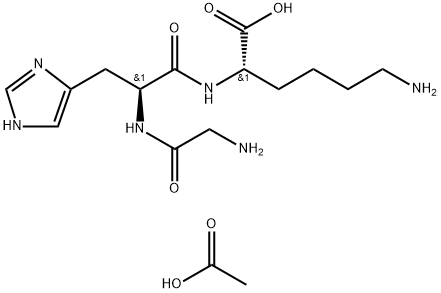Tripeptide-1 is a small peptide composed of three amino acids (glycine-histidine-lysine or GHK) and is known for type I collagen fragments. When collagen fragment peptides (GHK) are added, it may mistakenly lead the skin to think that collagen has been broken down, resulting in more collagen. Therefore, tripeptide-1 is believed to stimulate collagen production in the skin. More collagen will reduce wrinkles on the face, which will improve the condition of the skin.
Gly-His-Lys acetate salt has been used:
- individually or as a complex with copper to test its effect on cytokines production in the human normal fibroblasts cell lines
- as a model peptide in N,N-dimethyl-N-methacryloxyethyl-N-(3-sulfopropyl)ammonium betaine based capillary electrophoresis separation studies
- as a component of Coon′s modified Ham′s F-12 medium for culturing Fischer rat thyroid follicular cell line, FRTL-5
Gly-His-Lys is a tripeptide present at ~200ng/ml in association with α-globulin and albumin, in human blood plasma.
Gly-His-Lys (GHK) acetate salt displays affinity towards copper(II) ions. This property enables GHK to modulate the copper intake into cells. GHK is also involved in quenching toxic by-products generated by lipid peroxidation.
In an enzyme assay, the liver growth factor, Tripeptide-1, was hydrolyzed by an aminotripeptidase purified from rat brain cytosol[1].
Tripeptide-1 (1% in saline; dose = 10 mg/kg) was injected into the tail vein of male rats (number not specified). Blood samples were collected prior to dosing and for up to 60 minutes post-dosing. Plasma concentration-time profiles of Tripeptide-1 and its l-histidyl-l-lysine metabolite indicated that neither was detected in predose plasma samples. However, after intravenous (IV) injection, Tripeptide-1 was rapidly degraded to l histidyl-l-lysine, rapidly eliminated from circulating blood. It has been reported that Tripeptide-1 is unstable in human plasma and is rapidly degraded by aminopeptidases[1].
[1] Wilbur Johnson. “Safety Assessment of Tripeptide-1, Hexapeptide-12, Their Metal Salts and Fatty Acyl Derivatives, and Palmitoyl Tetrapeptide-7 as Used in Cosmetics.” International Journal of Toxicology 37 1 (2018): 102S–90S.



